The Cambridge History of Japan, Vol. 4: Early Modern Japan
Подождите немного. Документ загружается.


IMPLICATIONS OF CHANGES 695
or taxes, and to lives of poverty and hardship in the villages. But even
historians in this school offer evidence to the contrary, even for the
poorest regions of the northeast. They acknowledge an increase in the
consumption of sugar (which had to be imported from western Japan)
and fresh fish, an increase in the consumption of white rice and sake,
and much improved clothing. Even in Morioka, in the extreme north,
the deaths reported to the bakufu in the famine of the 1780s were
largely fictitious; certainly such vast numbers are not to be found in
the domain's own books.
33
Economic historians trained in modern economic theory are publish-
ing
a
growing number of quantitative studies that demonstrate that the
economy continued to grow in the eighteenth century, even if not at the
rate of the seventeenth, and that the standard of living by the early to
mid-nineteenth century was at Meiji levels in many respects.
34
Those
doing the quantitative studies have yet to obtain results that support the
Marxist
case.
This
is
not to
say
that
no
one died from lack of food or
as a
result of malnutrition but, rather, that during this period the Japanese
were not only able to support their large population - well over 25
million by the eighteenth century - but also to improve the life of the
average Japanese as well.
Dramatic evidence of the improvement in the rural standard of
living can be inferred from regulations governing goods permitted to
be sold in the rural districts of the daimyo domain of Okayama.
35
In
order to prevent the cultivators from wasting on small luxuries any
cash they might have, the domain first tried to place a total ban on
rural peddlers, but this was so openly violated that by 1666 peddlers
were allowed to sell eleven items considered necessities: fishing nets,
dried fish, salt, dried seaweed, tea, rapeseed oil, kindling, wooden
water dippers, oars, basket tops, and farm tools. As demand grew, the
rules had to be relaxed accordingly, and by 1705, thirty-one items were
permitted to be sold, including pottery, cotton, pans, rice pots, straw
mats,
paper, fans, and rulers. The number of peddlers more than
doubled between 1652 and 1707, and by the 1720s the domain discov-
33 For elaboration on Morioka, see chap. 6 of Hanley and Yamamura, Economic and Demo-
graphic Change, pp. 126-60.
34 These economic historians have organized a group for the study of quantitative economic
history. Key members include Hayami Akira and Nishikawa Shunsaku of Keio University,
Umemura Mataji and Saito Osamu of Hitotsubashi University, and Yasuba Yasukichi and
Miyamoto Matao of Osaka University.
35 Discussions of the regulations, their violations, and what was sold and how in the villages are
found in Ando Seiichi, Kinsei zaikata
shogyo no kenkyu
(Tokyo: Yoshikawa kobunkan, 1958),
pp.
125-8; and in Okayama shiyakusho, Okayama shishi, sangyo keizai hen (Okayama:
Okayama shiyakusho, 1966), pp. 164-5.
Cambridge Histories Online © Cambridge University Press, 2008
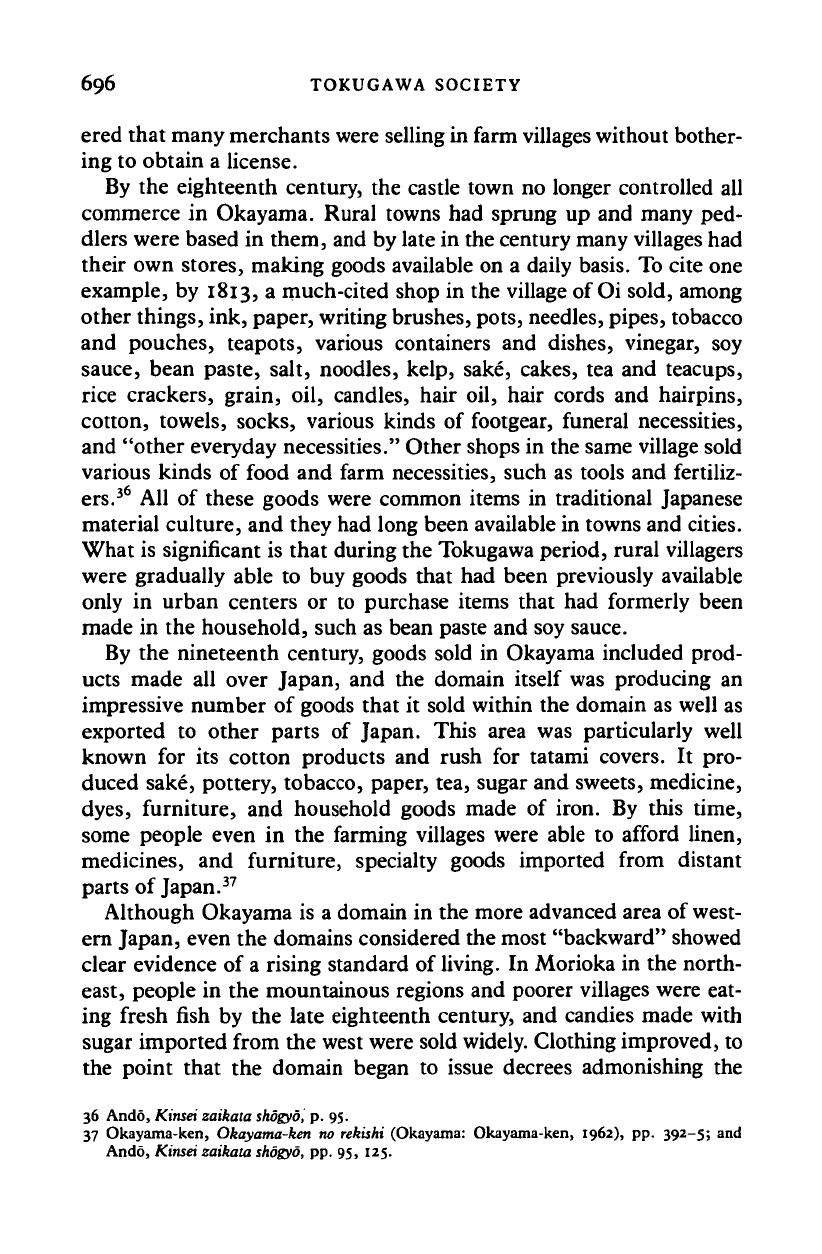
696 TOKUGAWA SOCIETY
ered that many merchants were selling in farm villages without bother-
ing to obtain a license.
By the eighteenth century, the castle town no longer controlled all
commerce in Okayama. Rural towns had sprung up and many ped-
dlers were based in them, and by late in the century many villages had
their own stores, making goods available on a daily basis. To cite one
example, by 1813, a much-cited shop in the village of Oi sold, among
other things, ink, paper, writing brushes, pots, needles, pipes, tobacco
and pouches, teapots, various containers and dishes, vinegar, soy
sauce, bean paste, salt, noodles, kelp, sake, cakes, tea and teacups,
rice crackers, grain, oil, candles, hair oil, hair cords and hairpins,
cotton, towels, socks, various kinds of footgear, funeral necessities,
and "other everyday necessities." Other shops in the same village sold
various kinds of food and farm necessities, such as tools and fertiliz-
ers.
36
All of these goods were common items in traditional Japanese
material culture, and they had long been available in towns and cities.
What is significant is that during the Tokugawa period, rural villagers
were gradually able to buy goods that had been previously available
only in urban centers or to purchase items that had formerly been
made in the household, such as bean paste and soy sauce.
By the nineteenth century, goods sold in Okayama included prod-
ucts made all over Japan, and the domain itself was producing an
impressive number of goods that it sold within the domain as well as
exported to other parts of Japan. This area was particularly well
known for its cotton products and rush for tatami covers. It pro-
duced sake, pottery, tobacco, paper, tea, sugar and sweets, medicine,
dyes,
furniture, and household goods made of iron. By this time,
some people even in the farming villages were able to afford linen,
medicines, and furniture, specialty goods imported from distant
parts of Japan.
37
Although Okayama is a domain in the more advanced area of west-
ern Japan, even the domains considered the most "backward" showed
clear evidence of a rising standard of living. In Morioka in the north-
east, people in the mountainous regions and poorer villages were eat-
ing fresh fish by the late eighteenth century, and candies made with
sugar imported from the west were sold widely. Clothing improved, to
the point that the domain began to issue decrees admonishing the
36 Ando, Kinsei zaikata shogyoi p. 95.
37 Okayama-ken, Okayama-ken no rekishi (Okayama: Okayama-ken, 1962), pp. 392-5; and
Ando,
Kinsei zaikata shogyo, pp. 95, 125.
Cambridge Histories Online © Cambridge University Press, 2008
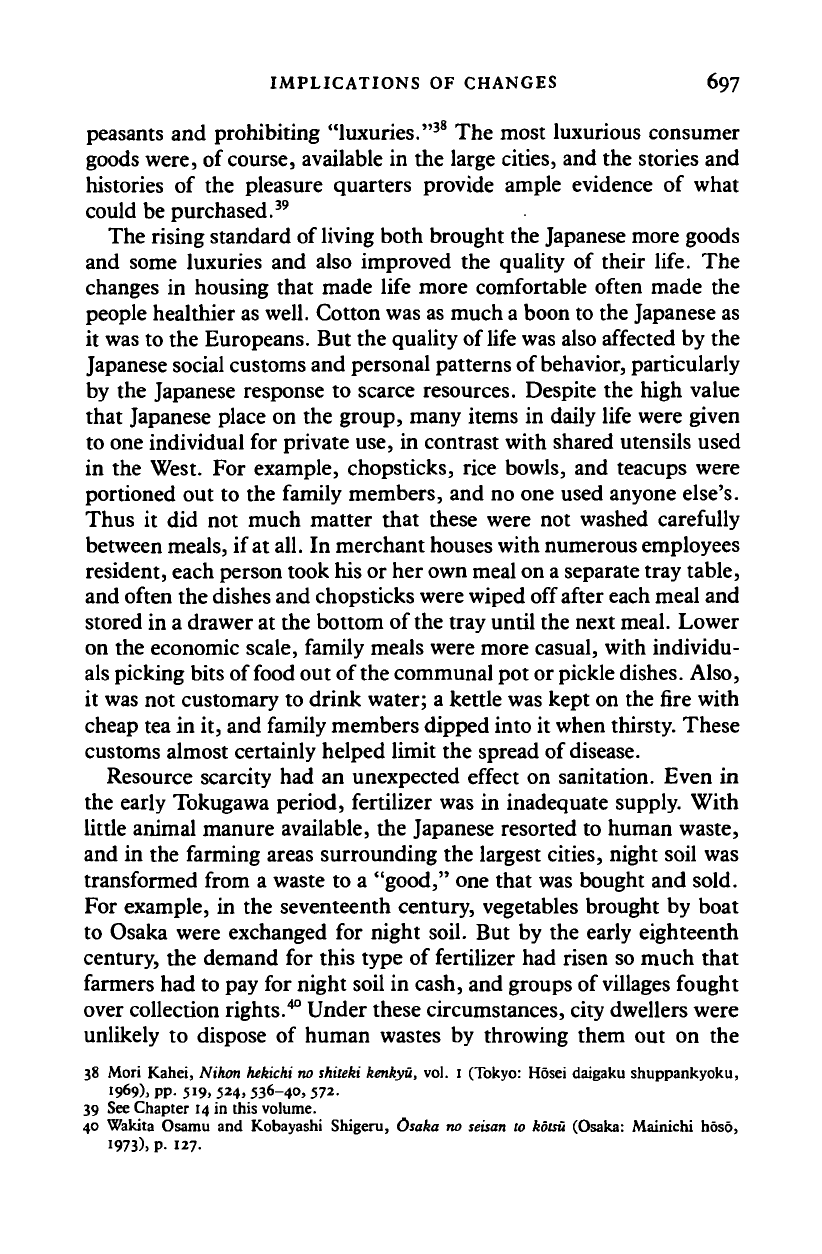
IMPLICATIONS OF CHANGES 697
peasants and prohibiting "luxuries."
38
The most luxurious consumer
goods were, of
course,
available in the large cities, and the stories and
histories of the pleasure quarters provide ample evidence of what
could be purchased.
39
The rising standard of living both brought the Japanese more goods
and some luxuries and also improved the quality of their life. The
changes in housing that made life more comfortable often made the
people healthier as well. Cotton was as much a boon to the Japanese as
it was to the Europeans. But the quality of life was also affected by the
Japanese social customs and personal patterns of behavior, particularly
by the Japanese response to scarce resources. Despite the high value
that Japanese place on the group, many items in daily life were given
to one individual for private use, in contrast with shared utensils used
in the West. For example, chopsticks, rice bowls, and teacups were
portioned out to the family members, and no one used anyone else's.
Thus it did not much matter that these were not washed carefully
between meals, if at
all.
In merchant houses with numerous employees
resident, each person took his or her own meal on a separate tray table,
and often the dishes and chopsticks were wiped off after each meal and
stored in a drawer at the bottom of
the
tray until the next meal. Lower
on the economic scale, family meals were more casual, with individu-
als picking bits of food out of the communal pot or pickle dishes. Also,
it was not customary to drink water; a kettle was kept on the fire with
cheap tea in it, and family members dipped into it when thirsty. These
customs almost certainly helped limit the spread of disease.
Resource scarcity had an unexpected effect on sanitation. Even in
the early Tokugawa period, fertilizer was in inadequate supply. With
little animal manure available, the Japanese resorted to human waste,
and in the farming areas surrounding the largest cities, night soil was
transformed from a waste to a "good," one that was bought and sold.
For example, in the seventeenth century, vegetables brought by boat
to Osaka were exchanged for night soil. But by the early eighteenth
century, the demand for this type of fertilizer had risen so much that
farmers had to pay for night soil in cash, and groups of villages fought
over collection rights.
40
Under these circumstances, city dwellers were
unlikely to dispose of human wastes by throwing them out on the
38 Mori Kahei, Nihon hekichi no shiteki kenkyu, vol. 1 (Tokyo: Hosei daigaku shuppankyoku,
«969).
PP- 519. 524. 536-40, 572-
39 See Chapter 14 in this volume.
40 Wakjta Osamu and Kobayashi Shigeru, Osaka no seisan 10 kotsu (Osaka: Mainichi hoso,
1973),
P- 127-
Cambridge Histories Online © Cambridge University Press, 2008
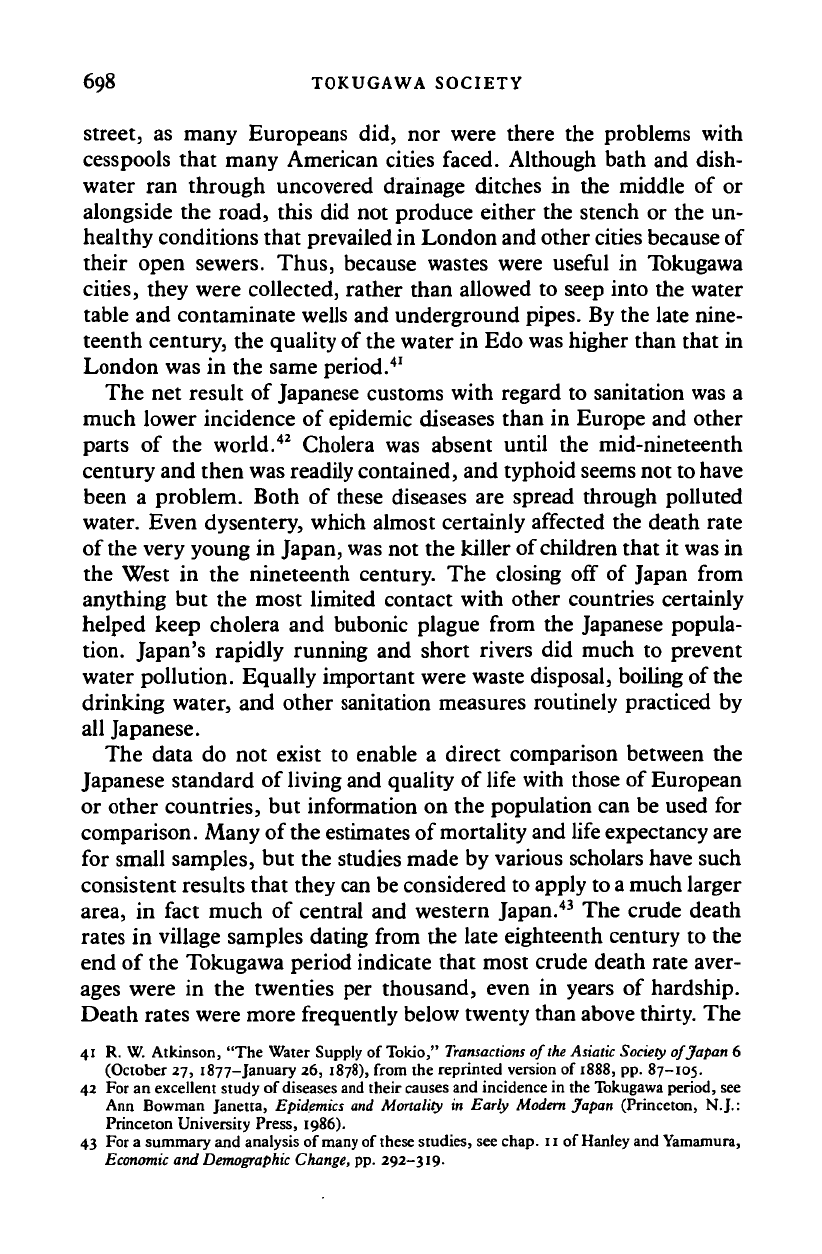
698 TOKUGAWA SOCIETY
street, as many Europeans did, nor were there the problems with
cesspools that many American cities faced. Although bath and dish-
water ran through uncovered drainage ditches in the middle of or
alongside the road, this did not produce either the stench or the un-
healthy conditions that prevailed in London and other cities because of
their open sewers. Thus, because wastes were useful in Tokugawa
cities,
they were collected, rather than allowed to seep into the water
table and contaminate wells and underground pipes. By the late nine-
teenth century, the quality of the water in Edo was higher than that in
London was in the same period.
41
The net result of Japanese customs with regard to sanitation was a
much lower incidence of epidemic diseases than in Europe and other
parts of the world.
42
Cholera was absent until the mid-nineteenth
century and then was readily contained, and typhoid seems not to have
been a problem. Both of these diseases are spread through polluted
water. Even dysentery, which almost certainly affected the death rate
of the very young in Japan, was not the killer of children that it was in
the West in the nineteenth century. The closing off of Japan from
anything but the most limited contact with other countries certainly
helped keep cholera and bubonic plague from the Japanese popula-
tion. Japan's rapidly running and short rivers did much to prevent
water pollution. Equally important were waste disposal, boiling of the
drinking water, and other sanitation measures routinely practiced by
all Japanese.
The data do not exist to enable a direct comparison between the
Japanese standard of living and quality of life with those of European
or other countries, but information on the population can be used for
comparison. Many of the estimates of mortality and life expectancy are
for small samples, but the studies made by various scholars have such
consistent results that they can be considered to apply to
a
much larger
area, in fact much of central and western Japan.
43
The crude death
rates in village samples dating from the late eighteenth century to the
end of the Tokugawa period indicate that most crude death rate aver-
ages were in the twenties per thousand, even in years of hardship.
Death rates were more frequently below twenty than above thirty. The
41 R. W. Atkinson, "The Water Supply of Tokio,"
Transactions
of the Asiatic Society of Japan 6
(October 27, 1877-January 26, 1878), from the reprinted version of 1888, pp. 87-105.
42 For an excellent study of diseases and their causes and incidence in the Tokugawa period, see
Ann Bowman Janetta, Epidemics and Mortality in Early Modem Japan (Princeton, N.J.:
Princeton University Press, 1986).
43 For a summary and analysis of many of these studies, see chap. 11 of Hanley and Yamamura,
Economic
and Demographic Change, pp. 292-319.
Cambridge Histories Online © Cambridge University Press, 2008
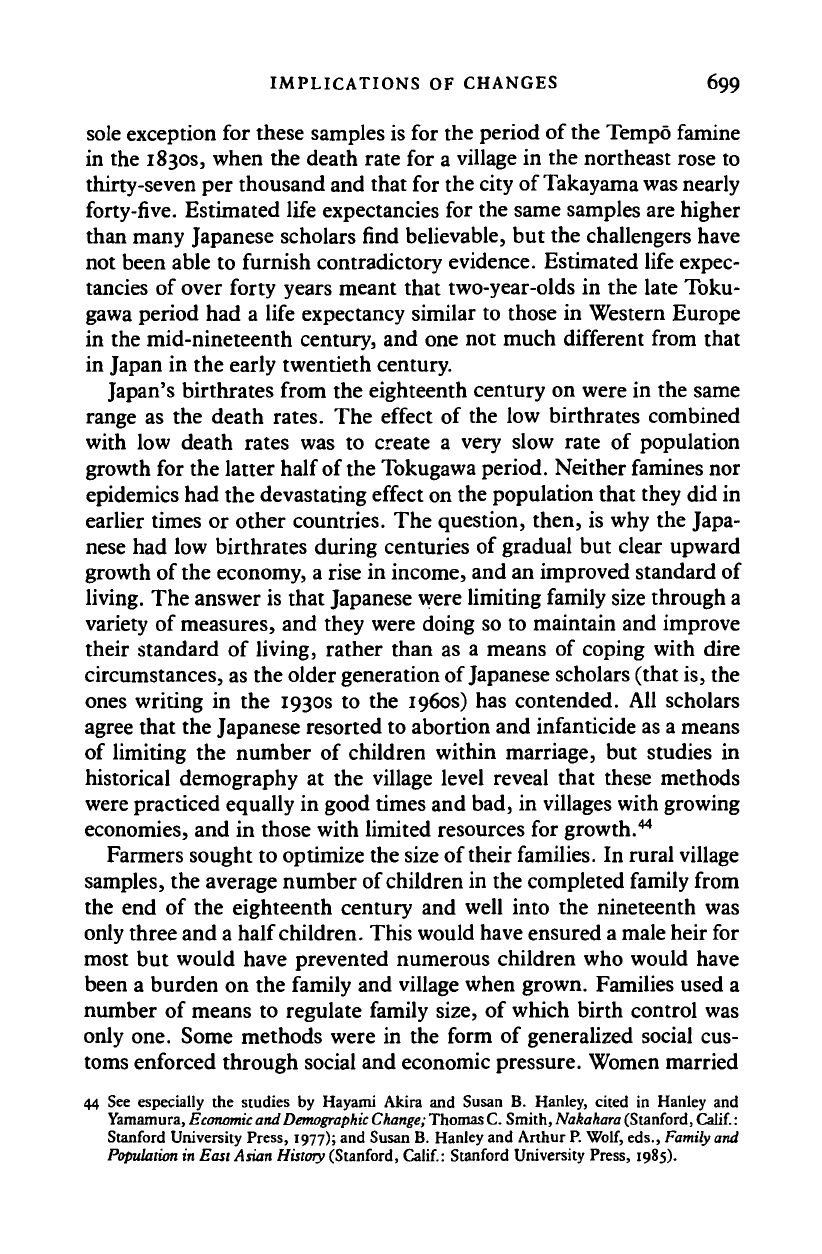
IMPLICATIONS
OF
CHANGES
699
sole exception
for
these samples
is for the
period
of
the Tempo famine
in
the
1830s, when
the
death rate
for a
village
in the
northeast rose
to
thirty-seven
per
thousand
and
that
for
the city
of
Takayama was nearly
forty-five. Estimated life expectancies
for the
same samples
are
higher
than many Japanese scholars find believable,
but the
challengers have
not been able
to
furnish contradictory evidence. Estimated life expec-
tancies
of
over forty years meant that two-year-olds
in the
late Toku-
gawa period
had a
life expectancy similar
to
those
in
Western Europe
in
the
mid-nineteenth century,
and one not
much different from that
in Japan
in the
early twentieth century.
Japan's birthrates from
the
eighteenth century
on
were
in the
same
range
as the
death rates.
The
effect
of the low
birthrates combined
with
low
death rates
was to
create
a
very slow rate
of
population
growth
for the
latter half of the Tokugawa period. Neither famines
nor
epidemics
had the
devastating effect
on the
population that they
did in
earlier times
or
other countries.
The
question, then,
is why the
Japa-
nese
had low
birthrates during centuries
of
gradual
but
clear upward
growth
of
the economy,
a
rise
in
income,
and an
improved standard
of
living.
The
answer
is
that Japanese were limiting family size through a
variety
of
measures,
and
they were doing
so to
maintain
and
improve
their standard
of
living, rather than
as a
means
of
coping with dire
circumstances,
as the
older generation of Japanese scholars (that is,
the
ones writing
in the
1930s
to the
1960s)
has
contended.
All
scholars
agree that
the
Japanese resorted
to
abortion
and
infanticide
as a
means
of limiting
the
number
of
children within marriage,
but
studies
in
historical demography
at the
village level reveal that these methods
were practiced equally
in
good times
and
bad,
in
villages with growing
economies,
and in
those with limited resources
for
growth.
44
Farmers sought
to
optimize
the
size of their families.
In
rural village
samples,
the
average number of children
in the
completed family from
the
end of the
eighteenth century
and
well into
the
nineteenth
was
only three
and a
half children. This would have ensured a male heir
for
most
but
would have prevented numerous children
who
would have
been
a
burden
on the
family
and
village when grown. Families used
a
number
of
means
to
regulate family size,
of
which birth control
was
only
one.
Some methods were
in the
form
of
generalized social
cus-
toms enforced through social
and
economic pressure. Women married
44
See
especially
the
studies
by
Hayami Akira
and
Susan
B.
Hanley, cited
in
Hanley
and
Yamamura, Economic and
Demographic
Change; Thomas C. Smith, Nakahara (Stanford,
Calif.:
Stanford University Press, 1977);
and
Susan
B.
Hanley
and
Arthur P.
Wolf, eds.,
Family and
Population
in
East Asian History (Stanford,
Calif.:
Stanford University Press, 1985).
Cambridge Histories Online © Cambridge University Press, 2008
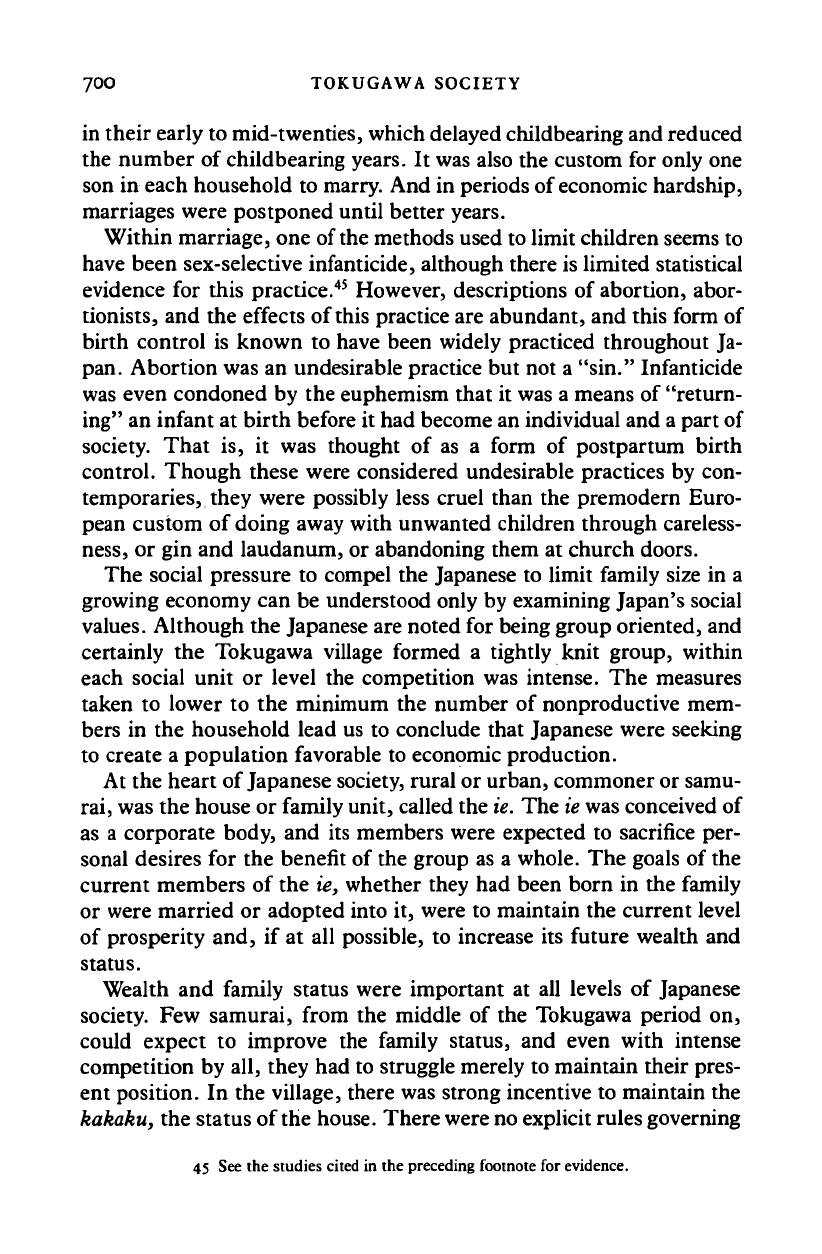
70O TOKUGAWA SOCIETY
in their early to mid-twenties, which delayed childbearing and reduced
the number
of
childbearing years.
It
was also the custom
for
only one
son
in
each household to marry. And in periods of economic hardship,
marriages were postponed until better years.
Within marriage, one of the methods used to limit children seems
to
have been sex-selective infanticide, although there is limited statistical
evidence
for
this practice.
45
However, descriptions
of
abortion, abor-
tionists,
and
the effects of
this
practice are abundant, and this form of
birth control
is
known
to
have been widely practiced throughout
Ja-
pan. Abortion was
an
undesirable practice but not a "sin." Infanticide
was even condoned
by
the euphemism that
it
was
a
means
of
"return-
ing" an infant
at
birth before
it
had become an individual and a part of
society. That
is, it was
thought
of as a
form
of
postpartum birth
control. Though these were considered undesirable practices
by
con-
temporaries, they were possibly less cruel than
the
premodern Euro-
pean custom
of
doing away with unwanted children through careless-
ness,
or
gin and laudanum,
or
abandoning them
at
church doors.
The social pressure
to
compel the Japanese
to
limit family size
in a
growing economy can be understood only by examining Japan's social
values. Although the Japanese are noted
for
being group oriented, and
certainly
the
Tokugawa village formed
a
tightly knit group, within
each social unit
or
level
the
competition was intense.
The
measures
taken
to
lower
to the
minimum
the
number
of
nonproductive mem-
bers
in the
household lead
us to
conclude that Japanese were seeking
to create
a
population favorable to economic production.
At the heart of Japanese society, rural or urban, commoner or samu-
rai,
was the house
or
family unit, called the
ie.
The
ie
was conceived of
as
a
corporate body,
and its
members were expected
to
sacrifice
per-
sonal desires
for the
benefit
of
the group as
a
whole. The goals
of
the
current members
of
the ie, whether they had been born
in
the family
or were married
or
adopted into
it,
were
to
maintain the current level
of prosperity and,
if at all
possible,
to
increase
its
future wealth
and
status.
Wealth
and
family status were important
at all
levels
of
Japanese
society.
Few
samurai, from
the
middle
of
the Tokugawa period
on,
could expect
to
improve
the
family status,
and
even with intense
competition by all, they had to struggle merely to maintain their pres-
ent position.
In
the village, there was strong incentive to maintain the
kakaku, the status of the house. There were no explicit rules governing
45
See the
studies cited
in the
preceding footnote for evidence.
Cambridge Histories Online © Cambridge University Press, 2008
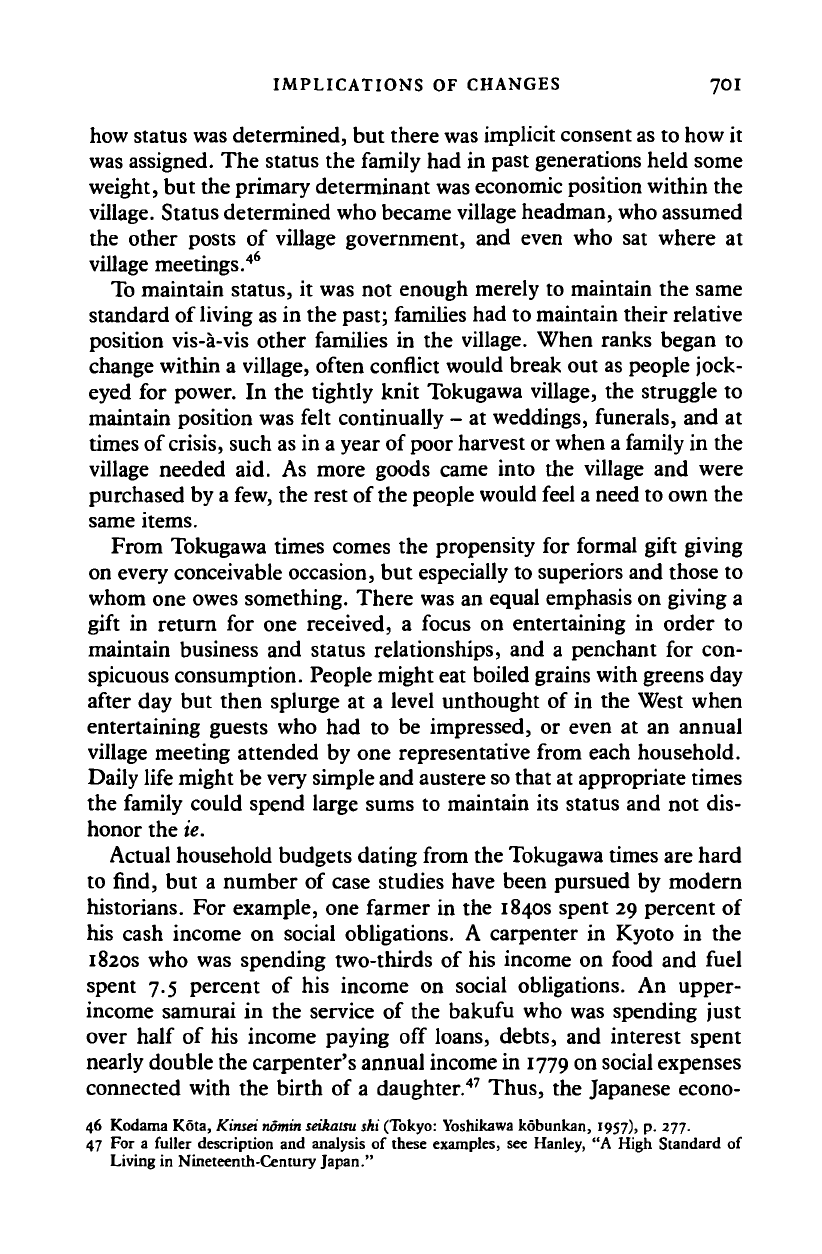
IMPLICATIONS OF CHANGES 701
how status was determined, but there was implicit consent as to how it
was assigned. The status the family had in past generations held some
weight, but the primary determinant was economic position within the
village. Status determined who became village headman, who assumed
the other posts of village government, and even who sat where at
village meetings.
46
To maintain status, it was not enough merely to maintain the same
standard of living as in the past; families had to maintain their relative
position vis-a-vis other families in the village. When ranks began to
change within a village, often conflict would break out as people jock-
eyed for power. In the tightly knit Tokugawa village, the struggle to
maintain position was felt continually - at weddings, funerals, and at
times of
crisis,
such as in a year of poor harvest or when a family in the
village needed aid. As more goods came into the village and were
purchased by a few, the rest of the people would feel a need to own the
same items.
From Tokugawa times comes the propensity for formal gift giving
on every conceivable occasion, but especially to superiors and those to
whom one owes something. There was an equal emphasis on giving a
gift in return for one received, a focus on entertaining in order to
maintain business and status relationships, and a penchant for con-
spicuous consumption. People might eat boiled grains with greens day
after day but then splurge at a level unthought of in the West when
entertaining guests who had to be impressed, or even at an annual
village meeting attended by one representative from each household.
Daily life might be very simple and austere so that at appropriate times
the family could spend large sums to maintain its status and not dis-
honor the ie.
Actual household budgets dating from the Tokugawa times are hard
to find, but a number of case studies have been pursued by modern
historians. For example, one farmer in the 1840s spent 29 percent of
his cash income on social obligations. A carpenter in Kyoto in the
1820s who was spending two-thirds of his income on food and fuel
spent 7.5 percent of his income on social obligations. An upper-
income samurai in the service of the bakufu who was spending just
over half of his income paying off loans, debts, and interest spent
nearly double the carpenter's annual income in
1779
on social expenses
connected with the birth of a daughter.
47
Thus, the Japanese econo-
46 Kodama Kota, Kinsei
nomin seikatsu
thi (Tokyo: Yoshikawa kobunkan, 1957), p. 277.
47 For a fuller description and analysis of these examples, see Hanley, "A High Standard of
Living in Nineteenth-Century Japan."
Cambridge Histories Online © Cambridge University Press, 2008
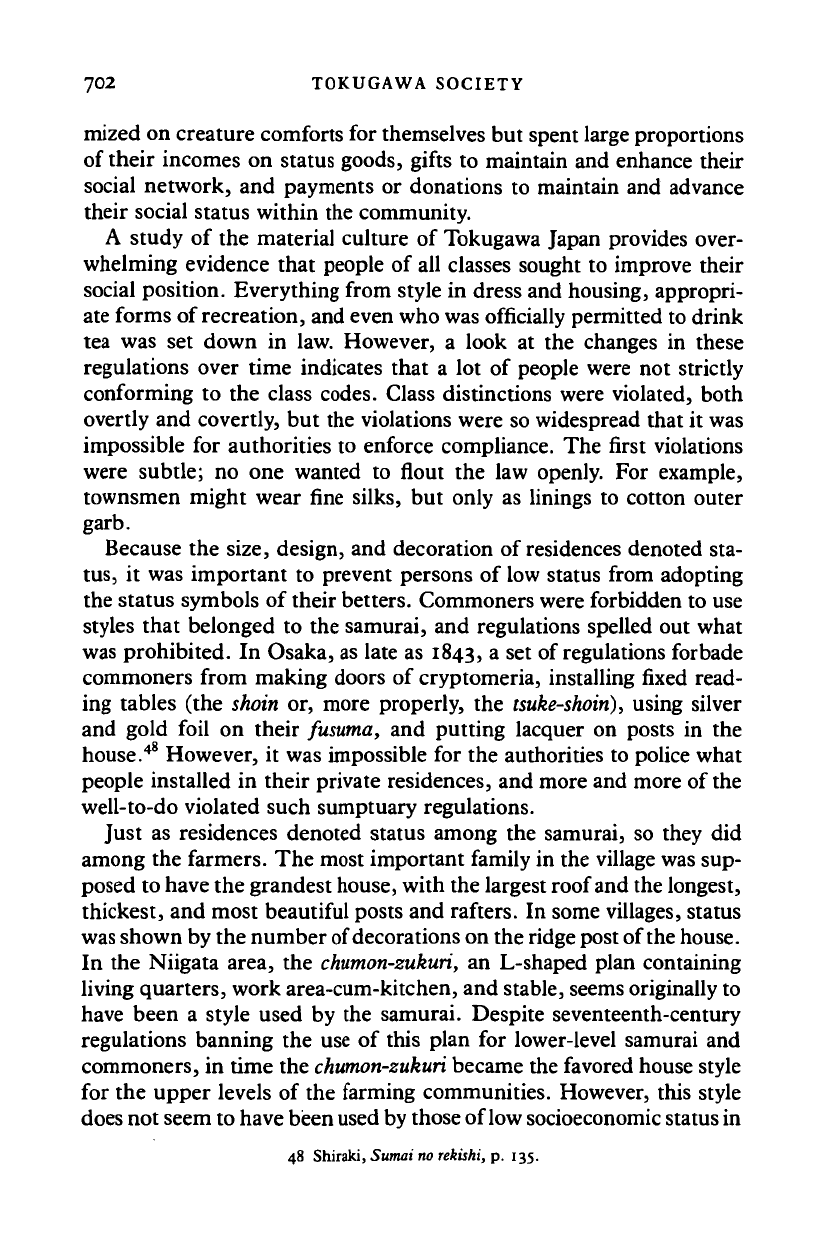
702 TOKUGAWA SOCIETY
mized on creature comforts for themselves but spent large proportions
of their incomes on status goods, gifts to maintain and enhance their
social network, and payments or donations to maintain and advance
their social status within the community.
A study of the material culture of Tokugawa Japan provides over-
whelming evidence that people of all classes sought to improve their
social position. Everything from style in dress and housing, appropri-
ate forms of recreation, and even who was officially permitted to drink
tea was set down in law. However, a look at the changes in these
regulations over time indicates that a lot of people were not strictly
conforming to the class codes. Class distinctions were violated, both
overtly and covertly, but the violations were so widespread that it was
impossible for authorities to enforce compliance. The first violations
were subtle; no one wanted to flout the law openly. For example,
townsmen might wear fine silks, but only as linings to cotton outer
garb.
Because the size, design, and decoration of residences denoted sta-
tus,
it was important to prevent persons of low status from adopting
the status symbols of their betters. Commoners were forbidden to use
styles that belonged to the samurai, and regulations spelled out what
was prohibited. In Osaka, as late as 1843, a set of regulations forbade
commoners from making doors of cryptomeria, installing fixed read-
ing tables (the shoin or, more properly, the
tsuke-shoin),
using silver
and gold foil on their fusuma, and putting lacquer on posts in the
house.
48
However, it was impossible for the authorities to police what
people installed in their private residences, and more and more of the
well-to-do violated such sumptuary regulations.
Just as residences denoted status among the samurai, so they did
among the farmers. The most important family in the village was sup-
posed to have the grandest house, with the largest roof and the longest,
thickest, and most beautiful posts and rafters. In some villages, status
was shown by the number of decorations on the ridge post of the house.
In the Niigata area, the
chumon-zukuri,
an L-shaped plan containing
living quarters, work area-cum-kitchen, and stable, seems originally to
have been a style used by the samurai. Despite seventeenth-century
regulations banning the use of this plan for lower-level samurai and
commoners, in time the
chumon-zukuri
became the favored house style
for the upper levels of the farming communities. However, this style
does not seem to have been used by those of low socioeconomic status in
48 Shiraki, Sumai no rekishi, p. 135.
Cambridge Histories Online © Cambridge University Press, 2008
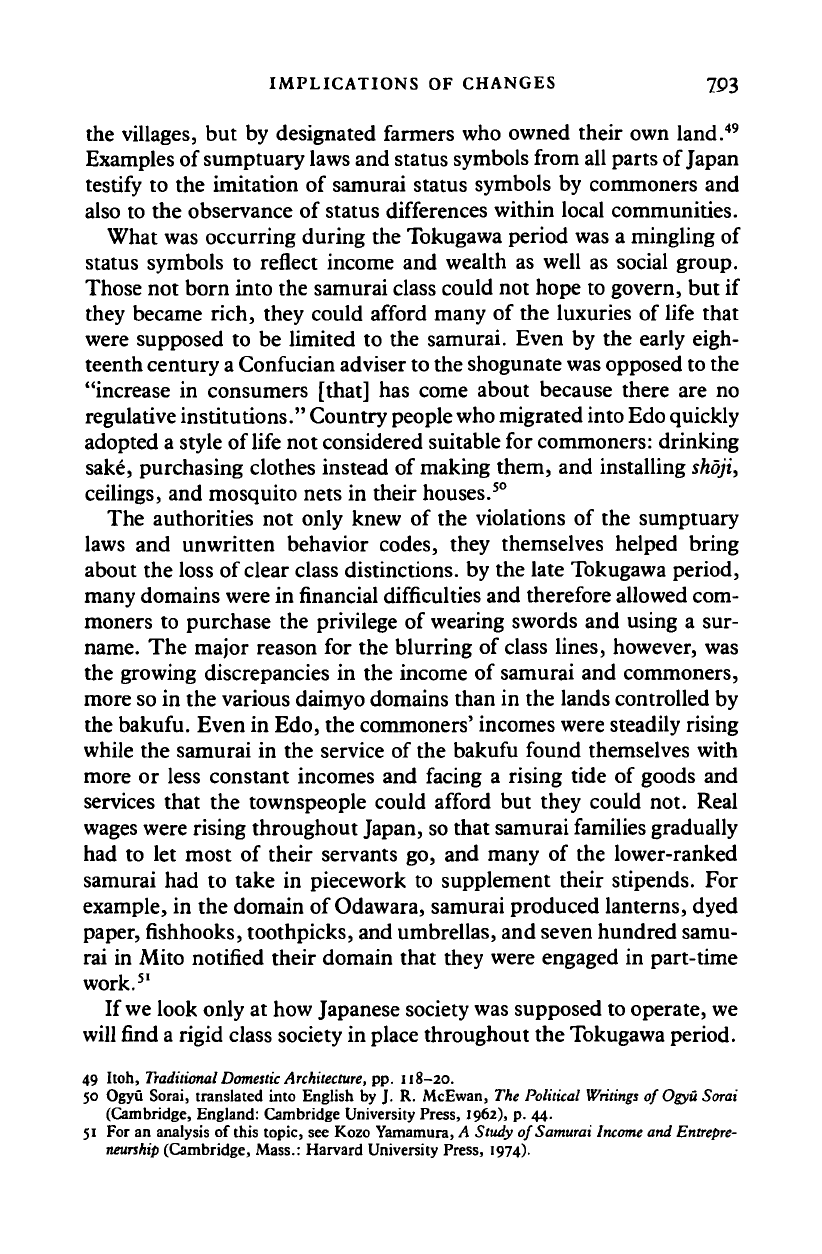
IMPLICATIONS OF CHANGES 793
the villages, but by designated farmers who owned their own land.
49
Examples of sumptuary laws and status symbols from all parts of Japan
testify to the imitation of samurai status symbols by commoners and
also to the observance of status differences within local communities.
What was occurring during the Tokugawa period was a mingling of
status symbols to reflect income and wealth as well as social group.
Those not born into the samurai class could not hope to govern, but if
they became rich, they could afford many of the luxuries of life that
were supposed to be limited to the samurai. Even by the early eigh-
teenth century
a
Confucian adviser to the shogunate
was
opposed to the
"increase in consumers [that] has come about because there are no
regulative institutions." Country people
who
migrated into
Edo
quickly
adopted a style of life not considered suitable for
commoners:
drinking
sake,
purchasing clothes instead of making them, and installing
shoji,
ceilings, and mosquito nets in their houses.
50
The authorities not only knew of the violations of the sumptuary
laws and unwritten behavior codes, they themselves helped bring
about the loss of clear class distinctions, by the late Tokugawa period,
many domains were in financial difficulties and therefore allowed com-
moners to purchase the privilege of wearing swords and using a sur-
name. The major reason for the blurring of class lines, however, was
the growing discrepancies in the income of samurai and commoners,
more so in the various daimyo domains than in the lands controlled by
the bakufu. Even in Edo, the commoners' incomes were steadily rising
while the samurai in the service of the bakufu found themselves with
more or less constant incomes and facing a rising tide of goods and
services that the townspeople could afford but they could not. Real
wages were rising throughout Japan, so that samurai families gradually
had to let most of their servants go, and many of the lower-ranked
samurai had to take in piecework to supplement their stipends. For
example, in the domain of Odawara, samurai produced lanterns, dyed
paper, fishhooks, toothpicks, and umbrellas, and seven hundred samu-
rai in Mito notified their domain that they were engaged in part-time
work.
5
'
If we look only at how Japanese society was supposed to operate, we
will find a rigid class society in place throughout the Tokugawa period.
49 Itoh,
Traditional Domestic
Architecture,
pp. 118-20.
50 Ogyu Sorai, translated into English by J. R. McEwan, The Political
Writings
ofOgyu Sorai
(Cambridge, England: Cambridge University Press, 1962), p. 44.
51 For an analysis of this topic, see Kozo Yamamura, A Study of Samurai
Income
and
Entrepre-
neurship
(Cambridge, Mass.: Harvard University Press, 1974).
Cambridge Histories Online © Cambridge University Press, 2008
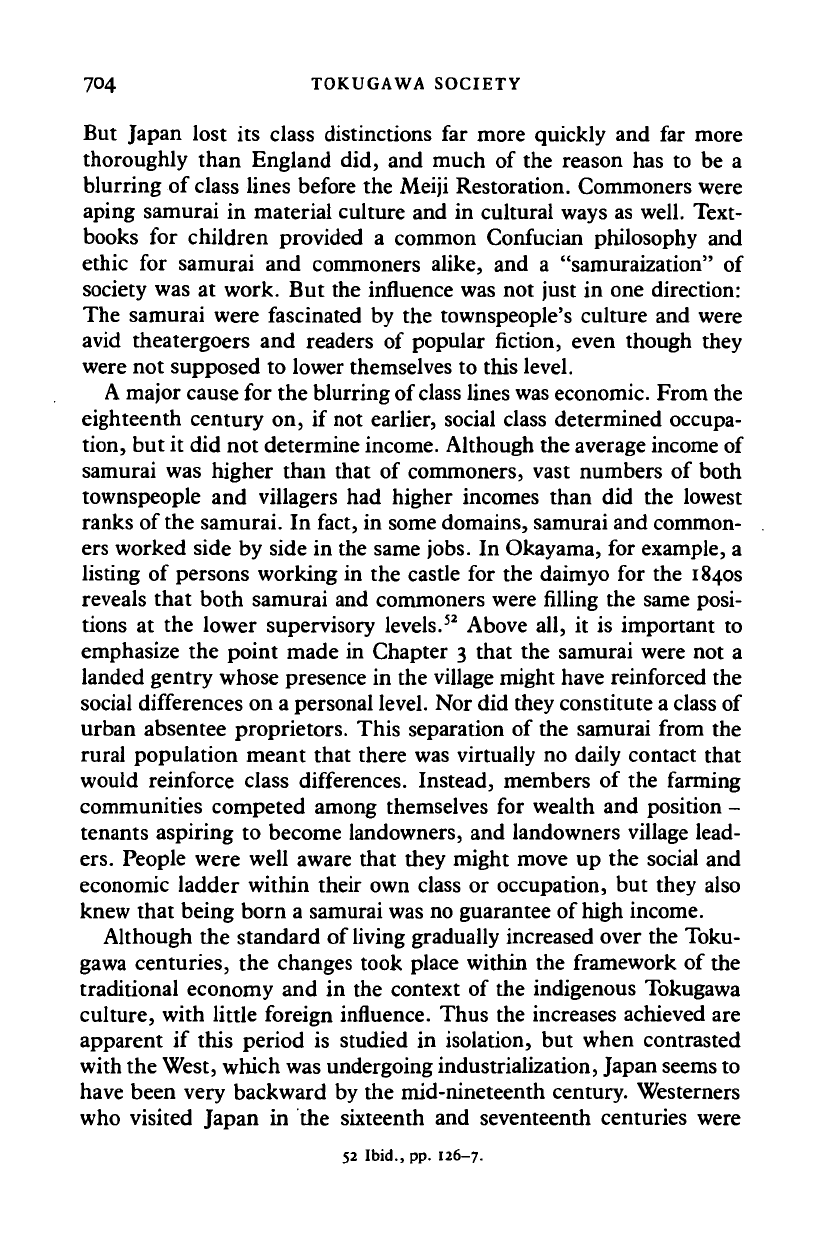
704 TOKUGAWA SOCIETY
But Japan lost its class distinctions far more quickly and far more
thoroughly than England did, and much of the reason has to be a
blurring of class lines before the Meiji Restoration. Commoners were
aping samurai in material culture and in cultural ways as well. Text-
books for children provided a common Confucian philosophy and
ethic for samurai and commoners alike, and a "samuraization" of
society was at work. But the influence was not just in one direction:
The samurai were fascinated by the townspeople's culture and were
avid theatergoers and readers of popular fiction, even though they
were not supposed to lower themselves to this level.
A major cause for the blurring of class lines was economic. From the
eighteenth century on, if not earlier, social class determined occupa-
tion, but it did not determine income. Although the average income of
samurai was higher than that of commoners, vast numbers of both
townspeople and villagers had higher incomes than did the lowest
ranks of the samurai. In fact, in some domains, samurai and common-
ers worked side by side in the same jobs. In Okayama, for example, a
listing of persons working in the castle for the daimyo for the 1840s
reveals that both samurai and commoners were filling the same posi-
tions at the lower supervisory levels.
52
Above all, it is important to
emphasize the point made in Chapter 3 that the samurai were not a
landed gentry whose presence in the village might have reinforced the
social differences on a personal
level.
Nor did they constitute a class of
urban absentee proprietors. This separation of the samurai from the
rural population meant that there was virtually no daily contact that
would reinforce class differences. Instead, members of the farming
communities competed among themselves for wealth and position -
tenants aspiring to become landowners, and landowners village lead-
ers.
People were well aware that they might move up the social and
economic ladder within their own class or occupation, but they also
knew that being born a samurai was no guarantee of high income.
Although the standard of living gradually increased over the Toku-
gawa centuries, the changes took place within the framework of the
traditional economy and in the context of the indigenous Tokugawa
culture, with little foreign influence. Thus the increases achieved are
apparent if this period is studied in isolation, but when contrasted
with the West, which was undergoing industrialization, Japan seems to
have been very backward by the mid-nineteenth century. Westerners
who visited Japan in the sixteenth and seventeenth centuries were
52 Ibid., pp. 126-7.
Cambridge Histories Online © Cambridge University Press, 2008
